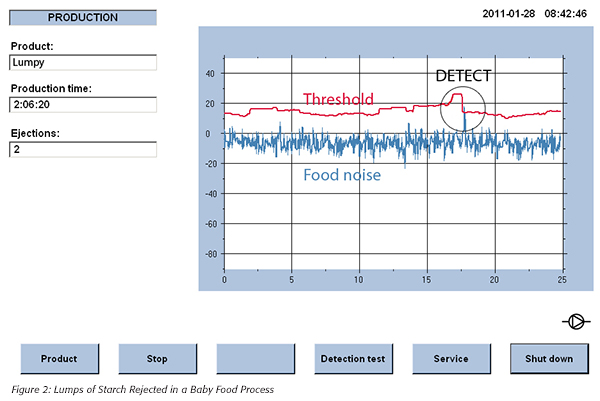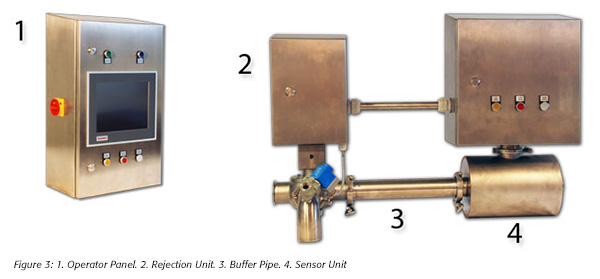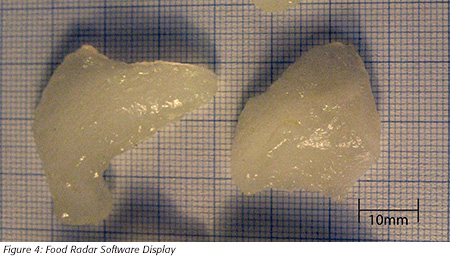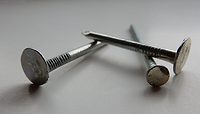When food is contaminated with foreign bodies, everyone loses, including the consumer, the retailer and the producer. The very real threat this poses to your customers, and to your business, makes this no laughing matter. Food Radar Systems AB of Sweden is taking the fight against food contamination to a whole new level, detecting types of foreign bodies that are all but invisible to traditional detection methods.
Although detection technologies have come a long way during the last few years, low-density foreign bodies such as plastic, wood and fruit stones are still invisible to all established detection systems—this is something that Food Radar Systems decided to change.
The Food Radar is the latest weapon in the arsenal of safety technology and is a sensor system designed for emulsions and pumpable products such as baby food, yogurt with fruit berries, spreads or, for example, tomato-based products. The system has the capability of detecting not only the denser foreign bodies (i.e., metal, stone and glass) but is particularly suited to foreign bodies such as wood, plastic, bone, extraneous vegetable matter and even insects that, up until now, have gone undetected and straight to the consumer.
Why consider this new technology?
1. Safety first
 A piece of hard plastic, which can be easily detected and removed by the Food Radar, can be as dangerous to consumers as a piece of glass. The protection your business will enjoy extends also to soft plastic (e.g., plastic bags), wood, pits and virtually all low-density foreign bodies (Figure 1).
A piece of hard plastic, which can be easily detected and removed by the Food Radar, can be as dangerous to consumers as a piece of glass. The protection your business will enjoy extends also to soft plastic (e.g., plastic bags), wood, pits and virtually all low-density foreign bodies (Figure 1).
 2. Quality and control
2. Quality and control
Even lumps of the food product itself (e.g., lumps of starch, spices, pasta or rice) can be detected and removed with no fuss (Figure 2). This technology can help safeguard the quality of product and the control over your manufacturing process.
3. Legal compliance
All food manufacturing is covered by the Food Safety Act (1990). The Act states that if food is contaminated by foreign bodies, or in some other way falls short of the standard demanded by the purchaser, the seller will have committed an offence. The Act also permits defense against prosecution based on taking ‘all reasonable precautions’ to prevent such occurrences. The Food Radar is a way of staying at the cutting-edge of quality assurance.
4. Good business
Any incidence of foreign body contamination is damaging to both the manufacturer and retailer. It can damage trust in the brand, and the cost in time and money of legal proceedings can be vast.
How it all works
 The technology is based on a unique and patented technique that uses microwaves to detect foreign bodies. The detection system is designed for clean-in-place and consists of four parts (Figure 3):
The technology is based on a unique and patented technique that uses microwaves to detect foreign bodies. The detection system is designed for clean-in-place and consists of four parts (Figure 3):
1. An operator panel
2. A sensor unit
3. A buffer pipe
4. A rejecter (valve) unit
All system components are hygienically contained in stainless steel cabinets, which are IP67 classified or higher. The sensor does not have any moving parts, and the rejection unit is a three-way valve, which has been certified by the European Hygienic Engineering & Design Group. The entire system takes up about one meter of pipe length and is, therefore, very convenient and easy to install.
The operator panel consists of a computer with a touchscreen interface. There is no need to calibrate the system for all your different products. It is normally enough with just two product group categories: smooth or particulate. The system is very user-friendly and the operator only needs to choose the right product group setting.
 The operator panel also provides statistics on the rejects and production time, as well as a display showing the product flow background noise and the threshold (Figure 4). When an object is detected, the signal crosses the threshold and the object is automatically rejected.
The operator panel also provides statistics on the rejects and production time, as well as a display showing the product flow background noise and the threshold (Figure 4). When an object is detected, the signal crosses the threshold and the object is automatically rejected.
The sensor unit consists of two parts (which are both inside the cabinet), a sensor head and a specially developed industrialized vector network analyzer, called the MTRX, which is controlled by the computer and generates a microwave signal. This microwave signal is then fed to the sensor head.
The sensor head is a piece of 2.5-inch, acid resistant stainless steel pipe, with eight hygienically sealed slots, through which the microwaves are transmitted and received.
The system measures the dielectric properties of the food flow and, if an object differs from the norm, it is detected and rejected from the flow.
The received microwave signal is digitized in the MTRX, and the measurement data are sent to the computer for processing. If an object is detected, the flow speed of the object is calculated and the computer sends this information back to the MTRX. The MTRX controls the exact timing of the signals to the pneumatic rejection unit, thus ensuring successful rejection of the contaminant. The information is then logged by the system, which can also e-mail a daily report to selected recipients.
The buffer pipe, located in between the sensor unit and the rejection unit, is optimized in length to ensure that the calculations can be performed in time and that the rejection unit is allowed enough time to open. The speed of the foreign object is measured and the eject signal is precisely defined, no matter if it is travelling at the center or towards the outer edge of the flow, which have very different speeds. The rejection opening time is optimized to ensure that the foreign body is ejected with minimal loss of product (only about two liters).
The system naturally monitors all functions and, should anything fall outside the norm, it will log the fault and alert the operator. It can also be remotely controlled via the Internet for monitoring and also to handle customer support issues.
Is it safe?
An important question with a simple answer: Yes, this is a safe technology, causing absolutely no damage to humans or the food being analyzed.
Microwaves are electromagnetic waves with a frequency of typically between 1,000 MHz (1 GHz) and 100 GHz. This is the same frequency at which microwave ovens and mobile phones work. The transmitted power level from the detection system is in the order of 0.001 W, and this is up to 1,000 times lower than the wattage emitted by a mobile phone. Compared to a microwave oven, the emissions of the system are between 500,000 to 1 million times lower.
Furthermore, the food being exposed to microwaves from the sensor is sealed inside a pipe. As water attenuates microwaves efficiently, the radiation that could possibly escape the pipe is extremely small and almost unmeasurable. Hence, the microwaves cause no heating of the food as it is pumped through the pipe system.
In summary, the microwave level used by the Food Radar is well within all safe levels.
Born in the industry!
The idea for the Food Radar really grew out of an industry need.
In the early 2000s, dialogues with major food companies increasingly highlighted the problem of undetectable objects, due to such causes as the growing usage of plastics in the industry. In response, The Swedish Institute for Food and Biotechnology (SIK) started a joint industrial project to address the growing problem of ‘undetectable’ foreign bodies. SIK had several years of microwave knowledge in-house and was located in Gothenburg, Sweden—one of the world’s real hubs of microwave technology experts. As a result, SIK enjoyed full access to world-class technology companies and specialists, including academia, who could help assess the concept.
The idea of a unique detection technology using microwave sensors soon created great enthusiasm among industry experts linked to the project. In 2003, SIK brought in external investors and Food Radar Systems AB was established as commercial company. The objective was to develop the technology and a system suited to the needs of the industry. In 2007, a prototype of a pipe sensor was tested, and, in 2009/2010, the company started to actively market its system towards certain applications.
Baby food taking the initiative
Food Radar Systems has installed detection systems at several global babyfood producers. It seems predictable that the baby food industry would be the first to adopt this new technology, as these manufacturers want, as much as any other company, to clearly demonstrate that they have taken all reasonable precautions against foreign bodies getting into their product. One company that has invested in multiple systems is H.J. Heinz. “We find this technology very interesting in helping to eliminate low-density foreign matter in particular plastics, thereby further ensuring the quality of the product we deliver to our consumers,” says Michael Philp, European Process Improvement Manager H.J. Heinz.
Manufacturers of fruit products have also identified the benefits this technology offers, not the least of which is because of the system’s ability to detect pits and fragments. Manufacturers of spreads, soups and sauces are also taking a closer look at the benefits offered by the Food Radar.
See for yourself!
In order to allow manufacturers to see for themselves how the system will work for them, they are able to test it at Food Radar Systems’ pilot plant in Gothenburg, even bringing with them their own product to test. This pilot plant is frequently visited by customers prior to making investment decisions.
‘Plug and play’
One of the great benefits is that the system really doesn’t need any floor space and does not make a footprint. It can be installed somewhere along the normal pipe, high or low at a suitable location somewhere before the filler. High-pressure air for the valve, water and power can all be arranged prior to installation. It is also practical to cut the production pipe at a convenient time before the unit has been delivered and install a temporary pipe section matching the system length. When installation is ready to commence, that section is removed and the unit is in place within 5–10 minutes.
The end result is an installation that does not interrupt production. Even while production is ongoing, the final connections (power, etc.) to the system can be done. It is as close to ‘plug and play’ as you can get when it comes to detection systems. The sensor unit, buffer pipe and rejection unit are installed at the pipe section, and the operator panel is positioned in the vicinity.
A new option
The LOOK 100® certainly gives quality assurance managers something extra to think about. What was previously considered an unbridgeable gap in foreign body detection has been closed by Food Radar Systems’ new microwave technology. It seems highly probable that, with the advent of the LOOK100®, manufacturers and consumers alike can look forward to a future with fewer episodes of food contamination.
For more information, please visit www.foodradar.com.


